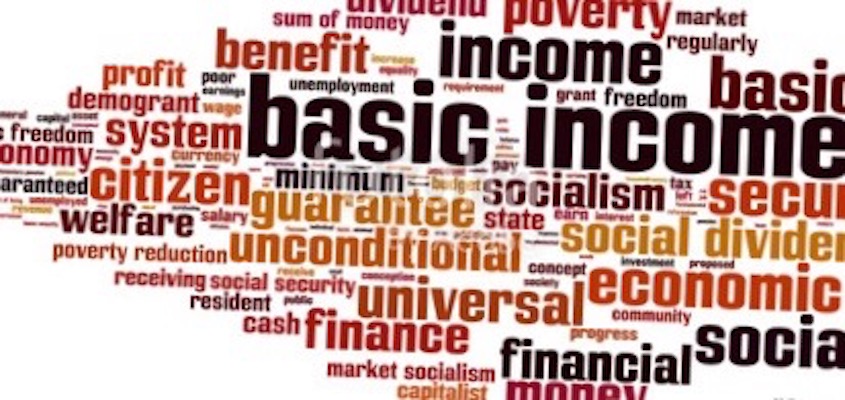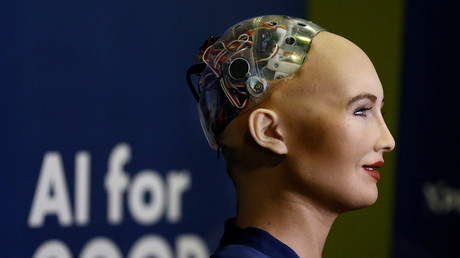Het betreft hier een uiterst intelligent schrijven van Brown, een artikel dat van groot belang kan zijn voor iedereen op onze kleine aarde: het uitroeien van armoede en een oplossing voor de tijd dat machines en computers het overgrote deel van de arbeid die de mens verricht zullen overnemen.
Praatjes dat de automatisering alleen maar meer banen zullen opleveren, zijn volkomen naast de waarheid...... Neem de betaalautomaten: deze automaten hebben duizenden bankmedewerkers de baan als loketmedewerker gekost..... Of wat dacht je van de automatisering in de landbouw, werk dat vroeger door tienduizenden arbeiders werd gedaan, kan nu in veel gevallen zelfs met 2 machines worden verricht, het in de grond stoppen van zaden en de oogst......
Met een basisinkomen kunnen we eindelijk aan het geluk van de mens werken, wel zal men daarvoor in het onderwijs ruimte vrij moeten maken voor lessen hoe om te gaan met vrije tijd, iets waar mensen niet goed in zijn en waar de meesten van ons pas achter komen bij werkloosheid en na pensionering..... (en dat is toch uitermate triest...)
Lees het volgende artikel en geeft het door:
Universal
Basic Income Is Easier Than It Looks

Ellen
Brown 09
Jan 2019
A
universal income program can help correct the debt bubble problem
without fear of “overheating” the economy.
“It
could actually be funded year after year without driving up taxes or
prices.”
Calls
for a Universal Basic Income (UBI) have been increasing, most
recently as part of the “Green New Deal” (GND) introduced by Rep.
Alexandria Ocasio-Cortez, D-N.Y., and supported
in the last month by
at least 40 members of Congress. A UBI is a monthly payment to all
adults with no strings attached, similar to Social Security. Critics
say the
Green New Deal asks too much of the rich and upper-middle-class
taxpayers who will have to pay for it, but taxing the rich is
not what
the resolution proposes .
It says funding would primarily come from the federal government,
“using a combination of the Federal Reserve, a new public bank or
system of regional and specialized public banks,” among other
vehicles.
The
Federal Reserve alone could do the job. It could buy “Green”
federal bonds with money created on its balance sheet, just as the
Fed funded the purchase of $3.7 trillion in bonds in its
“quantitative easing” program to save the banks. The Treasury
could also do it. The Treasury has the constitutional power to issue
coins in any denomination, even
trillion dollar coins .
What prevents legislators from pursuing those options is the fear of
hyperinflation from excess “demand” (spendable income) driving
prices up. But in fact the consumer economy is chronically short of
spendable income, due to the way money enters the consumer economy.
We actually needregular
injections of money to avoid a “balance sheet recession” and
allow for growth, and a UBI is one way to do it.
“Funding
would primarily come from the federal government, “using a
combination of the Federal Reserve, a new public bank or system of
regional and specialized public banks,”
The
pros and cons of a UBI are hotly debated and have been discussed
elsewhere .
The point here is to show that it could actually be funded year after
year without driving up taxes or prices.New money is continually
being added to the money supply, but it is added as debt created
privately by banks. (How banks, rather than the government, create
most of the money supply today is explained on the Bank of England
website here .)
A UBI would replace money-created-as-debt with debt-free money—a
“debt jubilee” for consumers—while leaving the money supply for
the most part unchanged; and to the extent that new money was added,
it could help create the demand needed to fill the gap between actual
and potential productivity.
The
Debt Overhang Crippling Economies
The
“bank money” composing most of the money in circulation is
created only when someone borrows, and today businesses and consumers
are burdened with debts that are higher than ever before. In 2018,
credit card debt alone exceeded $1 trillion, student debt exceeded
$1.5 trillion, auto loan debt exceeded $1.1 trillion, and
non-financial corporate debt hit $5.7 trillion. When businesses and
individuals pay down old loans rather than taking out new loans, the
money supply shrinks, causing a “balance sheet recession.” In
that situation, the central bank, rather than removing money from the
economy (as the Fed is doing now), needs to add money to fill the gap
between debt and the spendable income available to repay it.
Debt
always grows faster than the money available to repay it. One
problem is the interest ,
which is not created along with the principal, so more money is
always owed back than was created in the original loan. Beyond that,
some of the money created as debt is held
off the consumer market by “savers” and
investors who place it elsewhere, making it unavailable to companies
selling their wares and the wage-earners they employ. The result is a
debt bubble that continues to grow until it is not sustainable and
the system collapses, in the familiar death spiral euphemistically
called the “business cycle.” As economist Michael Hudson shows in
his 2018 book, “…
and Forgive Them Their Debts ,” this
inevitable debt overhang was corrected historically with periodic
“debt jubilees”—debt forgiveness—something he argues we need
to do again today.
For
governments, a
debt jubilee could be effected by
allowing the central bank to buy government securities and hold them
on its books. For individuals, one way to do it fairly across the
board would be with a UBI.
Why
a UBI Need Not Be Inflationary
In
a 2018 book called “The
Road to Debt Bondage: How Banks Create Unpayable Debt ,”
political economist Derryl Hermanutz proposes a central-bank-issued
UBI of $1,000 per month, credited directly to people’s bank
accounts. Assuming this payment went to all U.S. residents over 18,
or about 250 million people, the outlay would be about $2.5 trillion
annually. For people with overdue debt, Hermanutz proposes that it
automatically go to pay down those debts. Since
money is created as loans and extinguished when they are repaid, that
portion of a UBI disbursement would be extinguished along with the
debt.
People
who were current on their debts could choose whether or not to pay
them down, but many would also no doubt go for that option. Hermanutz
estimates that roughly half of a UBI payout could be extinguished in
this way through mandatory and voluntary loan repayments. That money
would not increase the money supply or demand. It would just allow
debtors to spend on necessities with debt-free money rather than
hocking their futures with unrepayable debt.
He
estimates that another third of a UBI disbursement would go to
“savers” who did not need the money for expenditures. This money,
too, would not be likely to drive up consumer prices, since it would
go into investment and savings vehicles rather than circulating in
the consumer economy. That leaves only about one-sixth of payouts, or
$400 billion, that would actually be competing for goods and
services; and that sum could easily be absorbed by the “output gap”
between actual and forecasted productivity.
“$2
trillion could be injected into the economy every
year without
creating price inflation.”
According
to a July 2017 paper from the Roosevelt Institute called “What
Recovery? The Case for Continued Expansionary Policy at the Fed ”:
“GDP remains well below both the long-run trend and the level
predicted by forecasters a decade ago. In 2016, real per capita GDP
was 10% below the Congressional Budget Office’s (CBO) 2006
forecast, and shows no signs of returning to the predicted level.”
The
report showed that the most likely explanation for this lackluster
growth was inadequate demand. Wages have remained stagnant; and
before producers will produce, they need customers knocking on their
doors.
In
2017, the U.S. Gross Domestic Product was $19.4 trillion. If the
economy is running at 10 percent below full capacity, $2 trillion
could be injected into the economy every
year without
creating price inflation. It would just generate the demand needed to
stimulate an additional $2 trillion in GDP. In fact a UBI might pay
for itself, just as the G.I.
Bill produced a sevenfold return from
increased productivity after World War II.
The
Evidence of China
That
new money can be injected year after year without triggering price
inflation is evident from a look at China. In the last 20 years, its
M2 money supply has grown from just over 10 trillion yuan to 80
trillion yuan ($11.6T), a nearly 800 percent increase. Yet the
inflation rate of its Consumer Price Index (CPI) remains a
modest 2.2 percent.
Why
has all that excess money not driven prices up? The answer is that
China’s Gross Domestic Product has grown at the same fast clip as
its money supply. When supply (GDP) and demand (money) increase
together, prices remain stable.
Whether
or not the Chinese government would approve of a UBI, it
does recognize that
to stimulate productivity, the money must get out there first;
and since the government owns 80 percent of China’s banks, it is in
a position to borrow money into existence as needed. For
“self-funding” loans—those that generate income (fees for rail
travel and electricity, rents for real estate)—repayment
extinguishes the debt along with the money it created, leaving the
net money supply unchanged. When loans are not repaid, the money they
created is not extinguished; but if it goes to consumers and
businesses that then buy goods and services with it, demand will
still stimulate the production of supply, so that supply and demand
rise together and prices remain stable.
Without
demand, producers will not produce and workers will not get hired,
leaving them without the funds to generate supply, in a vicious cycle
that leads to recession and depression. And that cycle is what our
own central bank is triggering now.
The
Fed Tightens the Screws
Rather
than stimulating the economy with new demand, the Fed has been
engaging in “quantitative tightening.” On Dec. 19, 2018, it
raised the Fed funds rate for the ninth time in three years, despite
a “brutal” stock market in which the Dow Jones Industrial Average
had already lost 3,000 points in 2 ½ months. The Fed is still
struggling to reach even its modest 2 percent inflation target, and
GDP growth is trending down, with estimates at only 2-2.7 percent for
2019. So why did it again raise rates, over
the protests of
commentators, including the president himself?
For
its barometer, the Fed looks at whether the economy has hit “full
employment,” which it considers to be 4.7 percent unemployment,
taking into account the “natural rate of unemployment” of people
between jobs or voluntarily out of work. At full employment, workers
are expected to demand more wages, causing prices to rise. But
unemployment is now officially at 3.7 percent—beyond technical
full employment—and neither wages nor consumer prices have shot up.
There is obviously something wrong with the theory, as is evident
from a look
at Japan ,
where prices have long refused to rise despite a serious lack of
workers.
The
official unemployment figures are actually misleading. Including
short-term discouraged workers, the rate of U.S. unemployed or
underemployed workers as of May 2018 was 7.6 percent, double
the widely reported rate .
When long-term discouraged workers are included, the
real unemployment figure was 21.5 percent .
Beyond that large untapped pool of workers, there is the seemingly
endless supply of cheap labor from abroad and the expanding labor
potential of robots, computers and machines. In fact, the economy’s
ability to generate supply in response to demand is far from reaching
full capacity today.
“When
long-term discouraged workers are included, the real unemployment
figure was 21.5 percent.”
Our
central bank is driving us into another recession based on bad
economic theory. Adding money to the economy for productive,
non-speculative purposes will not drive up prices so long as
materials and workers (human or mechanical) are available to create
the supply necessary to meet demand; and they are available now.
There will always be price increases in particular markets when there
are shortages, bottlenecks, monopolies or patents limiting
competition, but these increases are not due to an economy awash with
money. Housing, health care, education and gas have all gone up, but
it is not because people have too much money to spend. In fact it is
those necessary expenses that are driving people into unrepayable
debt, and it is this massive debt overhang that is preventing
economic growth.
Without
some form of debt jubilee, the debt bubble will continue to grow
until it can again no longer be sustained. A UBI can help correct
that problem without fear of “overheating” the economy, so long
as the new money is limited to filling the gap between real and
potential productivity and goes into generating jobs, building
infrastructure and providing for the needs of the people, rather than
being diverted into the speculative, parasitic economy that feeds off
them.
Ellen
Brown is an attorney, chairman of the Public Banking Institute, and
author of twelve books including "Web of Debt" and "The
Public Bank Solution."
COMMENTS?
Please
join the conversation on Black Agenda Report's Facebook page at
http://facebook.com/blackagendareport
Or,
you can comment by emailing us at comments@blackagendareport.com



